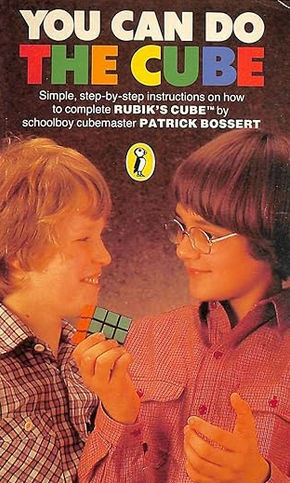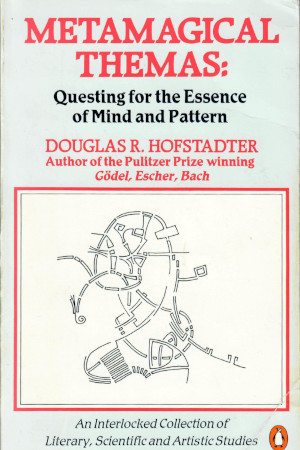When I was a child in the 1980s, I had a Rubik’s Cube and a copy of Patrick Bossert’s book “You Can Do The Cube” - and carefully following the instructions, it indeed turned out that I could.

So when we recently found ourselves with a Cube keyring, I wondered if I’d be able to do it again. An old copy of Bossert’s book was easy to find. Then, when I found that the quality of a mini Cube attached to a keyring isn’t always the best (any frustration should come from the solver, not the Cube itself, getting stuck!), I got a traditional full-sized model again. (Not a smartcube with Bluetooth, nor one with built-in magnets to help turns click exactly into place, which I learn are options now.)
Of course, the method still works. And once I was satisfied I still had a way to solve the Cube, I took a look around to see what other options are out there and how cubing has developed in the past 40 years…
How else can we do the Cube?
Approaches differ in which elements they tackle first, second etc. and how they set about solving those elements.
In the “You Can Do The Cube” method, you:
- Complete the top layer - corners first, then edges,
- Complete the bottom layer corners, and
- Complete the middle and bottom layer edges - get them into place, then flip them as needed.

Images from “You Can Do The Cube” (1981) by Patrick Bossert, published by Puffin.
It’s the method which worked for me, so I do have some nostalgic attachment to it.
But, I find this is rather different from the range of “beginner” methods I now see on the Internet (for example at Solve The Cube or CubeSkills) Most of these have an approach along the lines of:
- Complete the top layer - edges first, then corners,
- Complete the middle layer, and
- Complete the bottom layer - again, edges first, then corners

Images of the stages of a beginner’s method based on Solve The Cube, generated with the Rubik’s Cube Image Generator.
I may give these a try, to see if the consensus developed over the last 40 years has a point.
Then there are advanced approaches for more speed. The most popular is CFOP (named after the stages of “cross”, “first two layers”, “orientation of the last layer”, and “permutation of the last layer”). Alternatives include ZZ (distinctive for “twisting the edge pieces at the start to streamline the rest of the solve”) and Roux (which, instead of starting on a layer, starts by solving a 2x3x1 block). But Solve The Cube’s guide to CFOP warns the reader “Full CFOP takes some dedication. If you’ve just arrived at this website looking to learn how to solve a Rubik’s Cube and thought to yourself ‘Beginner my left foot, I’m starting with the speedcubing guide, that sounds fast’, then I warn you now: here be dragons.” So I don’t think I’ll be venturing there…
Can we use God’s Algorithm?
There is another theoretically elegant approach to solving the Cube.
A few years after I’d got a Cube, I read Douglas Hofstatder’s Metamagical Themas, a collection of his fascinating Scientific American columns from 1981-1983 - including a couple of chapters on the Cube, which was sweeping the world by storm in the early 1980s.

Hofstadter discussed the clever mechanical construction (none of the pieces except for the centres are attached, but they hold each other in place with plastic “feet” inside the Cube), dived into some permutation and group theory (including a proof of why you can reach only one-twelfth of the possible arrangements of a Cube by twisting it), and presented a neat way to solve the Cube - in principle.
Suppose you had the magical ability to tell, from the state of a scrambled Cube, the minimum number of moves needed to solve it - sometimes called “God’s Number” (how quickly could an omniscient entity complete it?). That then gives you an algorithm to actually solve the Cube. How? At each step…
- Consider the arrangements of the Cube after each possible next move.
- Determine God’s Number for each of those possible next arrangements.
- At least one of those possible next arrangements must be a first step along a shortest possible solution. So at least one of the possible next arrangements must have a God’s Number which is one less than God’s Number for the current arrangement. So - make a move to get to one of those arrangements, and that will be one step closer to a solved Cube.
- Repeat this process with the new arrangement of the Cube.
Knowing some graph theory and algorithms now, it seems less novel. But when I first saw this - seeing how to turn “knowing how far away we are” into “knowing what the route is” - was an “aha!” moment.
But - inconveniently, we don’t have a practical way to compute God’s Number for a scrambled Cube. So, while it’s theoretically elegant, it is useless in practice - and that’s why we need those methods like those above which explicitly find a solution, rather than a method which does little more than prove one exists.
(A note on terminology: “God’s Number” sometimes refers, as above, to the minimum number of moves to a particular scrambled Cube. It’s also used to mean the number of moves required from any position, i.e. the longest “shortest solution” across all possible Cubes. And this turns out to be 20.)
An extra twist
We then got a Cube with cartoons of sheep on six different coloured backgrounds. Out came trusty “You Can Do The Cube” to solve it as usual - but once it was done, some of the faces on the centre squares were upside-down or sideways, and our sheep looked like botched experiments of Frankenstein.
For standard Cubes, where those centre squares are simply solid colour, the guides don’t consider which way round they need to be, and I’d optimistically hoped that they’d automatically end up right once I’d done the rest of the Cube. But they don’t. Happily the Internet shows how a few more moves can turn them around - so the sheep, heads now facing the right way, can again safely graze in their green (and orange, and) pastures.
How may Cubes could you have solved in the time to read this?
The blogging software estimates this post is a 6-minute read. The current world record for solving a single 3x3x3 Cube is 3.05 seconds (although competitors are also allowed 15 seconds inspection time before they start solving) - so in that time, a record speedcuber could solve around 20 Cubes. (Me? I can get one side done and make decent progress on the rest - of Cube number one.)
Comments: Comment on this article on BlueSky or on Mastodon.
Subscribe to the newsletter: If you would like to be notified of new posts on this Eclectic Stacks blog, please subscribe to the free email newsletter (hosted with Buttondown).
You can subscribe either on the newsletter home page, or directly using the form below: